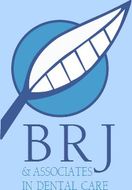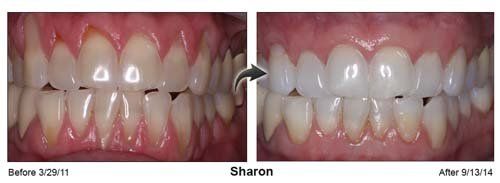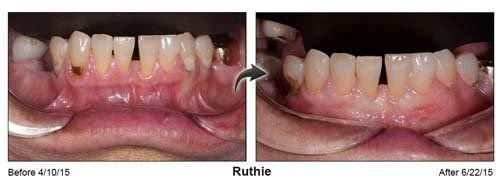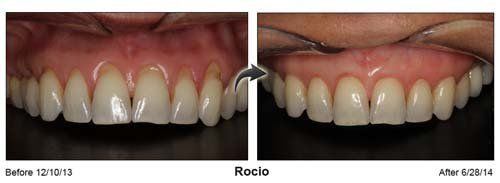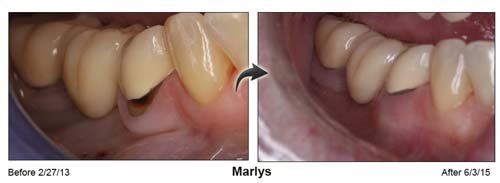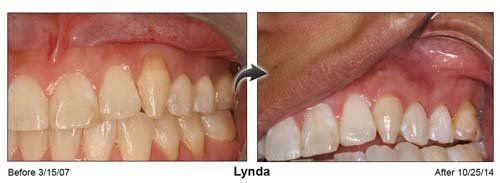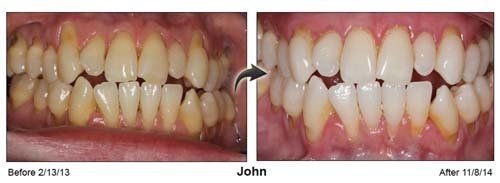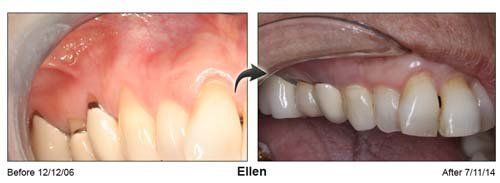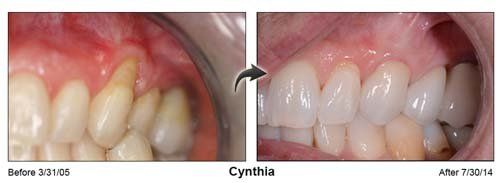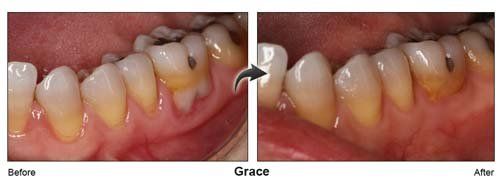Dental Services in Greater Cleveland Area
Dr. Jaffe
has completed a general practice residency at the University of Rochester as well as a two-year extended program in orthodontics
given by the American Orthodontic Society at Duquesne University in Pittsburgh. Dr. Jaffe is a Diplomate and Fellow of the American Orthodontic Society Board. He has presented cases and contributed to courses at Dallas, Texas; Seattle, Washington; Greenbelt, Maryland and Pittsburgh, Pennsylvania.
Integrating multiple treatment specialties into his practice allows comprehensive total treatment. Several doctors allow for consultation regarding diagnosis and treatment, as well as convenient and extended office hours.
Take a minute to visit our contact us page and send us an email with your questions or call us directly to set up a consultation.
Orthodontic treatment and braces can help both children and adults develop attractive and healthy smiles. In addition, orthodontic therapy corrects irregularities of the bite and facial structures of the mouth and jaw area that can improve your appearance as well as the health of your teeth, gums and jaw joints.
Braces are not just for children. Teeth can be straightened at any age, and many adults now turn to orthodontic treatment to correct their smile, enhance their self-confidence, and improve their oral and overall health.
Left untreated, many orthodontic problems become worse. Some of the most common reasons for considering orthodontic treatment include:
- Teeth which are too crowded. These teeth may be difficult to clean and maintain, making them prone to tooth decay, gum disease and eventual tooth loss.
- Teeth that are too far apart. This condition can often result in healthy teeth becoming loose or tipping into the open spaces. Deterioration of the supporting bone can also result in this situation.
- Protruding upper or lower teeth. Besides being unattractive, these teeth can cause abnormal wear of teeth surfaces and excess stress on supporting gum and bone tissue.
- Misalignment of jaw joints. Abnormal teeth position can affect the jaw joints where they hinge and result in chronic headaches or pains in the face or neck.
The cost of orthodontic treatment depends on the severity of your problem. Convenient financing with an initial down payment and monthly installments can usually be arranged.
For more information
on orthodontic treatment speak with Dr. Jaffe. A beautiful, healthy smile can change the way you look at the world-and the way the world looks at you.
The following topics will help you understand orthodontics and how it can create that "beautiful smile" for yourself and for your child:
Q: What is orthodontics?
A: Orthodontics is the specialty branch of dentistry that focuses entirely on the diagnosis, prevention, and treatment of dental and facial irregularities. The technical term for these problems is "malocclusion" which means "bad bite." Orthodontics utilizes corrective fixed and removable appliances (braces and retainers) to bring teeth, lips, and jaws into proper alignment for proper function and facial balance.
Q: When should orthodontic treatment begin?
A: Dr. Jaffe recommends early evaluation of developing malocclusions. Often early treatment, Stage I, can correct or minimize a problem so subsequent treatment is less complicated and less costly.
Q: What is Phase I and Phase II treatment?
A: Phase I treatment as early as age eight or nine involves correction of cross bites, over bites, under bites and harmful habits such as thumb sucking. Early treatment may involve partial braces to expand space for developing adult teeth. Not all children need interceptive Phase I treatment, but a screening examination is very important to make this determination. Phase II treatment involves full braces after all the adult teeth are in. The quality of the result in Phase II often depends on effective Phase I treatment.
Q: What about adult treatment?
A: Orthodontic treatment can be accomplished at any age. The health of the gums and supportive bone is very important in successful adult orthodontic treatment. Because an adult's facial bones are no longer growing, certain extreme corrections involving jaw and bone misalignment cannot be accomplished with braces alone. In some cases, adult orthodontic treatment may have to be combined with facial jaw surgery to achieve the desired result.
Q: What will treatment cost?
A: The actual cost of orthodontic treatment varies widely depending on the severity of the problem. Dr. Jaffe will discuss fees prior to beginning treatment. Insurance benefits and convenient financing can be arranged to help offset the cost of treatment. When you consider the cost of orthodontic treatment, be sure to keep in mind the many long-term benefits provided.
Q: What about clear braces?
A: Clear or ceramic brackets blend into the color of the natural tooth and are less obvious. They can be used – especially for adult treatment.
Invisalign® is comprised of a series of clear, formed and removable appliances which are used to gently move teeth. While effective in certain cases – Dr. Jaffe can discuss the pros and cons of Invisalign®.
Oral Surgery
Dental Implants
These are devices which secure replacement teeth to the bone and gum. In addition to stabilizing loose teeth or problem dentures, implants are often required for bridgework after teeth have been removed. By strengthening the natural bond between the teeth and oral tissues, dental implants can eliminate the physical discomfort associated with the loss of teeth.
Cosmetic Surgery
Most corrective surgery is done to correct functional problems, but cosmetic surgery can be done too, and, at the same time! The doctor will be happy to discuss the coordination of functional and cosmetic treatments.
Preprosthetic Surgery
If you are constantly troubled by loose dentures, you may be suffering from a loss of or change in the supporting gum tissue and bone. Often the dentures only need to be relined to restore a proper fit and healthy tissues. In cases of more severe bone deterioration, the affected teeth and/or surrounding soft or hard tissue may be augmented or reconstructed ("built up") to prevent further loss.
Facial Injuries
Facial injuries include cuts, bruises, lacerations, abrasions and fractures, and can result in damaged or lost teeth. The signs of severe injuries tend to show up in the two moving areas of the face-the eyes and the mouth. Typical indications of a jaw, cheekbone or eye socket fracturing are:
- Ill-fitting teeth or clicking jaw joint
- Eyes that don't move together
- Impaired or double vision
- An inability to open the mouth (due to the jaw catching on the fractured bone)
- Difficulty in breathing, eating or speaking
- Swelling over the injured area
Despite a high success rate for treating facial injuries, there is no substitute for prevention. Many sports- and accident-related injuries could have been avoided if a seat belt, mouth guard, face mask, helmet or other safety device had been worn.
Tooth Removal
Persistent pain in the jaw or gum; or early redness or swelling in the back of the mouth; or a discharge, abscess or foul taste indicate an impacted or infected tooth. Tooth extractions can be accompanied by premedication and/or anesthetic to reduce normal anxiety and eliminate pain.
Cyst & Tumor Removal
Being alert to the physical warning signs of a developing cyst or tumor is critical to its timely diagnosis and treatment. Most oral tumors are benign and easily removed. Nevertheless, we urge you to seek prompt, professional attention if you have any of the following symptoms:
- Mouth sore, lump or other suspicious growth that has not healed in two weeks
- Discharge or pus or other fluid
- White or red patches inside the mouth
- Swelling that last longer than one week
- Change in taste or eating habits
The doctor often performs a biopsy to confirm the diagnosis and determine a specific treatment plan. During the biopsy, a small tissue sample is removed from the affected area for further testing. The doctor will discuss the results of the biopsy with you and plan further treatment if necessary.
Our early diagnostic procedure for suspicious red or white lesions is the CDX brush biopsy. Similar to a "Pap" smear, a scraping of the questionable lesion is submitted to the lab for microscopic evaluation. This is quick and painless. No suspicious area should be ignored!
Infection Control
In order to protect you as well as ourselves, our office uses state of the art infection control procedures. We meet or exceed all OSHA, ADA, CDC guidelines.
We routinely utilize "universal precautions" and "barrier techniques."
"Universal precaution" is the practice of using the same infection control techniques for all patients and members of the surgical team. "Barrier technique" means the surgical team will wear gloves, masks and protective eye shields when performing surgical procedures. This creates a barrier to prevent contact with blood or body fluids and thus prevent transmission of contaminants from one person to another.
Standard infection control procedures include steam sterilization of all surgical instruments as well as drills following each procedure. All potential contaminated room surfaces and equipment are disinfected as well. All injectables are disposable and never reused.
All contaminated materials are specially packaged and disposed of following OSHA guidelines and state regulations.
If you have any questions about our infection control practices, ask us. We will be happy to discuss them with you.
Gum Disease/Periodontics
Periodontal diseases which attack the gums, bone and ligaments that support the teeth are a leading cause of tooth loss in adults. In fact, more than half of all people over the age of 18 have at least the early stages of some type of periodontal disease. By age 35, three out of four people are affected; however, periodontal diseases can strike at any age. Children as young as 5 or 6 can have signs of some of these diseases. Periodontal diseases are usually painless, and they may develop slowly or progress quite rapidly. Without regular checkups, you may not be aware that you have a periodontal disease until your gums and bone have been damaged to the point where tooth loss is inevitable.
Periodontal diseases can be prevented, however, it's important to understand what causes them, practice good oral health care habits and see your dentist on a regular basis.
The Causes of Periodontal Diseases
Periodontal diseases are caused by certain types of bacteria in plaque, the sticky, colorless film of bacteria that constantly forms on your teeth. These bacteria create toxins which irritate the gums and result in the breakdown of the attachment of gum tissues to your teeth. Over time, these toxins can destroy gum tissues and lead to bone loss.
In addition, plaque that is not removed from your teeth can combine with other materials and harden into a rough, porous deposit called calculus or tartar. Calculus on the surface of your teeth, above the gum line, may not contribute to periodontal diseases. Calculus on the root surface below the gums, however, makes removal of new plaque and bacteria more difficult. And unlike plaque which you can remove, only a dentist or dental hygienist can remove calculus.
Although periodontal diseases are caused by plaque, other factors can increase the risk, severity and speed of the condition's development. These factors include:
- Smoking or chewing tobacco
- Poorly fitting bridges, badly aligned teeth or defective fillings
- Habits such as clenching or grinding your teeth
- Poor or unbalanced diets
- Pregnancy or the use of oral contraceptives
- Systemic diseases such as diabetes
- Use of some types of medications
Types of Periodontal Diseases
There are many types of periodontal diseases, but the most common types are gingivitis and adult periodontitis. Gingivitis is the earliest stage and affects gum tissue only. At this stage, the disease can still be treated and reversed. Left unchecked, however, gingivitis can lead to more serious problems. Periodontitis is the more advanced stage of periodontal diseases. Gums, bone and other structures that support the teeth can become so severely damaged that teeth become loose and fall out. At this point, complex treatments may be required to prevent tooth loss.
Preventing Periodontal Diseases
You can avoid periodontal diseases and keep your teeth and gums healthy by taking proper care of them. First, keep your teeth clean by brushing thoroughly at least twice a day to remove plaque. Use a soft bristled toothbrush that is in good condition. Worn-out or hard bristled brushes can injure your gums. Use dental floss to help remove plaque between teeth. Gingivitis can often be reversed by regular daily brushing and cleaning between teeth. Fluoride toothpastes and mouth rinses are recommended to help prevent tooth decay. Dr. Jaffe may also suggest the use of an antimicrobial rinse as an effective supplement to your daily oral hygiene regimen.
Next, eat a healthy balanced diet consisting of foods from the basic food groups. These foods will help to provide adequate proteins, carbohydrates, fats vitamins, minerals and water.
Third, be sure to schedule regular checkups with your dentist. Professional cleaning is essential to preventing periodontal diseases. Call the office immediately if you notice any of the following warning signs:
- Gums that bleed easily
- Red, swollen or tender gums
- Gums that have pulled away from the teeth
- Pus between the teeth and gums when the gums are pressed
- Persistent bad breath or bad taste
- Permanent teeth that are loose or separating
- Any change in your bite or the way your teeth fit together
- Any changes in the fit of your partial dentures
You may be suffering from periodontal disease without any of these signals, so it's important to see your dentist
regularly.
Treating Periodontal Diseases
Treatment depends on the type of disease and the extent to which it has progressed. Regardless of the treatment plan, good daily oral hygiene is essential to the success of any periodontal therapy.
The first step is usually a thorough cleaning which may include "scaling" to remove plaque and calculus deposits below the gum line. Tooth roots may also be "planed" to smooth the root surface to allow gum tissue to heal. Antibiotics or irrigation with antimicrobial agents or rinses may be recommended to help control the growth of bacteria which cause periodontitis.
Medications placed under the gum tissue against the tooth root enhance healing. Conservative scaling with chemotherapeutic agents is the preferred initial periodontal therapy.
In some cases, surgery may be required when deeper pockets are found. It is difficult for the dentist or hygienist to thoroughly remove plaque and calculus from deep pockets, and patients can rarely keep them clean and free of plaque. Allowing these deep pockets to go untreated can result in infection and bone damage. When pockets are deep and bone has been destroyed, "flap surgery" may be required to provide access to the roots in order to remove plaque, calculus and damaged tissue. This technique involves lifting the gum away and suturing it back in place or into a new position that will be easier to keep clean. Bone surgery is sometimes used in conjunction with flap surgery to reshape the bone around the tooth.
Surgical procedures to correct areas of moderate to severe recession may be indicated. Good daily oral hygiene is a key element of any treatment of periodontal disease. The office will also schedule appointments at regular intervals as part of your treatment plan to assure that you are maintaining a satisfactory level of oral hygiene to remove any accumulated plaque or calculus and be sure that your periodontal disease remains under control.
Remember, periodontal diseases can be avoided by brushing and cleaning your teeth daily, eating a balanced diet, and regular maintenance appointments.
Cosmetic Dentistry
Cosmetic dentistry techniques are available to enhance the appearance of your smile or correct other problems with your mouth, teeth, jaws and facial structures.
Modern cosmetic dentistry can restore your teeth to their original shape, appearance and function. By using cosmetic bonded materials, your dentist can generally achieve 95 percent of your natural tooth strength, with no metal taste, unsightly gray margins or dark opaque look. Natural-appearing fillings, veneers, crowns and bridges utilizing polymer/glass/ceramic materials offer bio compatibility, esthetics, strength, versatility, stain resistance and wear resistance.
By integrating orthodontics, periodontics, smile design and oral surgery with restorative procedures, even the most severe cases finish with dramatic results.
New techniques such as power bleaching, microabrasion, air abrasion, laser/light-enhanced curing and laser/electrosurgery provide a variety of treatment options to alter and enhance your appearance. In addition, oral surgery, including dental implants
and cosmetic surgery, allow for total face and image enhancement.
Implants
If you are like many people, you may have lost one or more permanent teeth during your lifetime. And you may also know how hard it is to get back the chewing ability and appearance of your own natural teeth. If that's the case, you'll be happy to know that modern dentistry has good news for you and the millions of people like you who have to deal with the eating problems and appearance embarrassment caused by missing teeth. Dental implants represent a big step toward giving you new, artificial teeth that look natural, feel great and function with strength and security. Stable chewing and a great smile can become a reality for you.
What Is a Dental Implant?
Each dental implant consists of three components:
- The implant body, or anchor, which is surgically placed into bone
- The post to which the new artificial tooth or teeth are attached
- The new tooth or teeth
In fact, dental implants can help to replace one tooth or several teeth. In addition, implants can be used to provide support for a partial denture
or act as attachments for a full denture.
Are Implants Right for Me?
To help evaluate your potential as an implant patient, a comprehensive examination including appropriate x-rays, study models, and bite registration will be performed.
In addition to helping determine if you can receive dental implants, this information will also help determine which type of implant will best suit your needs and exactly where it should be placed.
As good as all of this may sound, it's important that you understand that as much as you may need them, there may be reasons why you can't get dental implants. Because of the surgical procedures required for implant placement, you must be in good health, have healthy gums, have enough good, strong bone in the right places, and be ready to make an extra effort to have regular dental checkups and meticulous oral hygiene.
How Are Implants Placed?
Implants require an important time and budget commitment. They typically cost more than full dentures or removable partial dentures, and the process may require up to nine months from start to finish.
The implant body, or anchor, is placed surgically. The careful and precise surgery may take several hours, and up to six months may be needed to allow your bone to grow around the implant and hold it securely and permanently in place. A second, more simple surgery may be needed to get the implant body ready to receive the post. Special care is taken at all times during and after these procedures to ensure that you are completely comfortable. After the healing is complete, restorative teeth are created and fitted to the post portion of the implant. Because of the precision required, these final steps in the restoration of the implants may require several months.
Mini-Implants
An exciting implant alternative is the mini-implant. These small diameter implants require minimally invasive surgery, can be restored immediately, and are less costly than standard implants. Mini-implants have specific indications and cannot be placed in all situations. Dr. Jaffe can discuss this newest option.
Benefits & Risks
Implants can provide new teeth that look more natural and allow you to chew with more security, that is, more like natural teeth. Patients who have difficulty with conventional full or removable partial dentures may enjoy improved function with implants.
Sometimes an implant can cause "stress" to the surrounding bone. If bone loss results from this situation, or if poor daily cleaning creates an infection, the implant may loosen and it may have to be removed. An implant failure may result in difficulties in further restorative efforts. Other possible complications include poor implant position due to available bone support, compromised esthetics, implant or component fracture, inadequate healing response, or damage to adjacent natural teeth.
How Do I Take Care of My New Implants?
Since there is always the chance of a gum infection, proper brushing, flossing and cleaning of your implants, along with regular dental checkups, are all extremely important for long-term success. Dr. Jaffe will give you specific instructions about the care of your implants. On a regular basis, we will evaluate the gum tissue around the implant and the attachment of the implant within the bone. With reasonable care, you can expect your implants to provide years of excellent service.
What Materials Are Used to Make the New Teeth Which Are Attached to Implants?
Replacement teeth are made of porcelain, metal, or polymer resin-the same types of materials used to create conventional dentures, removable partial dentures, and conventional crowns and bridges. The implant bodies and posts are made from a number of materials, including titanium which is often used because of its compatibility with natural tissues such as bone and gum tissues.
After the Implants Are Placed, How Are They Used to Replace Teeth?
The new teeth which are attached to the implants may be created in several different forms to satisfy each patient's individual needs. Replacement of a single tooth is usually accomplished with a single crown created to fit over the post attachment to the implant body. Several teeth missing in one area can be replaced with several crowns joined together to form a conventional bridge, which is then attached to posts which are attached to two or more implants. In some special situations, a bar may be fitted over posts attached to several implants. Such a bar may serve as the support for a removable partial denture or a full denture, depending on the number and location of the missing teeth.
If you are considering dental implants, meet with Dr. Jaffe, learn as much as you can, and then make the decision that best suits your needs. If you're having difficulty chewing, if lack of bone support means that your dentures are often uncomfortable, or if you're looking for a way to replace one tooth or several teeth in one area, implants could be the solution. Dental implants could make a big difference in the way you look, the enjoyment and nutrition you get from a wider variety of your favorite foods, and in the overall quality of your life.
Bite Problems/TMJ
The teeth and jaw joints are part of a system of structures referred to as the masticatory system. Consisting of four parts (the teeth, gums, jaw muscles and jaw joints), all parts of this system interact with each other as a part of the system. Breakdown may occur in these parts as a result of microbes (tooth decay, gingivitis) or excessive mechanical stress. Excessive mechanical stress may occur from outside trauma, such as an automobile accident, but more commonly occurs when the upper and lower teeth don't fit together where the jaw muscles best close the jaw. This condition defines a bite problem. It may result in damage to, or pain in, the teeth (worn, loose or cracked teeth), the gums (receding gums), the jaw joint (jaw noise or pain) or the jaw muscles (headaches, sore jaws).
Treatment
of this disorder should first be aimed at reducing the cause of the problem (mechanical stress) to a level which will prevent further structural damage or eliminate pain. Then, repair of damaged structures may be done. Depending upon the case, this may be accomplished by altering the bite, restoration of teeth or TMJ surgery.
Fillings, Crowns, Bridges
Modern dentistry has seen remarkable advancements in the way your teeth can be restored or replaced should the need arise. In just the last few years there have been many exciting improvements in the materials and techniques that allow dentists to restore and replace teeth with incredibly natural-looking filling materials and with onlays and crowns that look so much like natural teeth that you can hardly tell the difference.
New Materials for Fillings & Crowns
When teeth develop cavities, once the decay is removed, the "hole" has to be filled with a suitable material. Depending on the size of the "hole," a suitable material can be selected to "fill it." For many years, amalgam (silver) and gold were the materials most often used for fillings. Today, there are several other materials that offer the strength of metals with the beauty of tooth-colored porcelains and composites. These materials are bonded or cemented to the teeth to restore them to their original shape and strength. These restorations reinforce and support the tooth unlike the older amalgams which relied on the tooth and pins and posts to hold them together. This type of aesthetic dentistry
can enhance and improve your smile tremendously. Gold onlays and crowns are still an excellent material for use in the back of the mouth where they are not visible.
Bridges
A "bridge" is a restoration which replaces or spans the space where one or more teeth have been lost. There are two types of bridges: fixed and removable. Fixed bridges are cemented into place and can only be removed by a dentist. A removable bridge or "partial denture," conversely, can be taken out by the patient for cleaning. While less costly, removable bridges may not be as desirable as fixed bridges and are not generally as stable.
Your appearance, dental health and the proper functioning of your mouth are all important reasons for having a bridge placed. A bridge helps maintain the natural shape of your face by supporting your lips and cheeks. The loss of your back teeth may cause your bite to collapse and your face to droop and appear older. More importantly, however, when teeth are not replaced your overall dental health may suffer significantly. Your teeth were designed to complement each other. When a tooth is lost, the nearby teeth may tip into the empty space, and the teeth in the opposite jaw may move up or down toward the open space. This places unusual stress on both the teeth and the supporting tissues in your mouth. The gum tissues and the bone that holds your teeth in place can break down, increasing the risk of gum disease. Teeth that have drifted are difficult to clean thoroughly, making them more likely to decay. As a result, even more teeth may be lost.
Missing teeth can also affect the way you chew and speak. Chewing on only one side of your mouth puts stress on your mouth and jaws. Your teeth are also needed to speak properly, as they help you make the many sounds needed to speak. Bridges can be made to attach to your own remaining permanent teeth as well as to dental implants. They can be made of gold or porcelain tooth-colored materials, and with proper home care and regular dental examinations to monitor fit and support, your bridge should last for many years.
Dentures/Partial Dentures
If you've lost all of your natural teeth, for whatever reason, full dentures can replace your missing teeth and improve your smile and self-confidence. You'll be able to eat and speak better – two things that most people usually take for granted until they lose all of their natural teeth.
A full denture, also called a complete denture, provides support for your cheeks and lips by replacing missing natural teeth and the bone and gum tissue that held them in place. Without support from the denture, your facial muscles will sag, giving you a droopy, tired and much older appearance.
Dentures can be created to very closely resemble the appearance of natural healthy teeth. In fact, there may be little change in your appearance, and there's a good chance that your smile may become the healthy, natural appearing smile you've always wanted.
There are four types of complete dentures. The type of denture technique used is based upon the individual needs of each patient.
- Conventional Full Denture - This is created and placed in the patient's mouth after all of the remaining natural teeth, either upper jaw, lower jaw, or both, have been removed and the gum tissue has healed. Several months may be required to ensure complete healing.
- Immediate Full Denture - This is placed in the patient’s mouth immediately after the remaining natural teeth have been extracted, at the same visit. Several preliminary appointments with the dentist, and possibly an oral surgeon, are used to create the final denture and prepare the patient for the surgical visit. It's important to note that with an immediate full denture, the patient does not have to be without teeth during the healing period. Immediate full dentures usually will require a reline procedure to readapt the lining of the denture to the final contours of the healed tissue. In some special situations, the immediate full denture may function as an interim or temporary denture to accommodate the patient's chewing and appearance needs during healing. In these situations, a new, conventional denture will be created to replace the immediate full denture.
- Overdenture - If you have a few healthy natural teeth, the teeth may be modified so that their roots may be used to support the base of a complete full denture. Root canal therapy is performed on the teeth that will be used for support. Then, the height of each tooth is reduced to the level of the gum line. In this way, the roots-and the bone and gum tissue which holds the roots in place, can give additional support for the full denture. This is especially important for lower full dentures which can be difficult to maintain in place with stability.
- Implant Supported Full Denture - A complete denture can be made to fit over dental implants, which can serve as artificial roots in the manner of an overdenture. In some cases, retentive attachments are placed on each implant and within the denture base. The denture can then be snapped in and out. In other cases, a bar is created to fit over the posts attached to the implants. In this situation, the retentive attachments are part of the bar and the denture base, and once again, the full denture snaps onto the bar. Well-placed implants with healthy gum tissue can actually help reduce jaw and gum tissue shrinkage as time goes by. This can be an important element in denture stability and comfort.
- Denture Adhesives - Although dentures are made to fit securely, a denture adhesive may be suggested to help during the adjustment period. This will provide a feeling of tightness and stability and help the retention of dentures which lack needed bone support.
A loose denture, which makes chewing difficult and can change facial features, may be helped by a reline. A denture that doesn't fit properly may cause irritation, sores or infection. Denture adhesives can temporarily help loose fitting dentures, but long-term use of adhesives may not be a good idea since they may mask the real reason that the denture is loose. If in doubt, check with Dr. Jaffe.
Caring for Dentures
Just like your natural teeth, dentures must be properly cared for. They can actually be very delicate and may break, chip or crack if dropped just a few inches. When handling your dentures, stand over a folded towel or a sink filled with water. When you're not wearing your dentures, store them safely away from pets and children.
Daily brushing will remove food deposits and plaque and helps to prevent the denture teeth from becoming permanently stained. It's best to use a specially-designed denture cleaning brush, although a soft bristled brush can also be used. Don't use hard bristled brushes which can cause unnecessary wear. An ultrasonic cleaner can also be used, but it's no substitute for a thorough daily cleaning.
To clean the denture, rinse off loose food particles, moisten the brush, and use it to apply the denture cleaner. Be sure to brush all surfaces of the dentures.
Store the denture in water, since allowing the denture base to dry out can cause changes in its shape which will affect its fit. Do not store the denture in hot water, however, since that will also change its shape. When you're not wearing them, store your dentures in a cleaning solution or plain water. Look for denture solutions that display the American Dental Association's Seal of Acceptance which represents safety and effectiveness.
Denture Adjustments
Call the office
immediately if your dentures break, crack, chip, or if any of the denture teeth become loose or come out. Your dentist should be the only one to make adjustments and repairs. A person who lacks the proper training will not be able to make, repair or adjust the denture. The denture can be damaged, its fit and function may be seriously harmed, and oral tissues can be changed and permanently damaged. Never attempt to repair your dentures with over-the-counter glues. They are not effective, and often contain harmful chemicals. Don't use them.
Denture Replacement
Eventually, your dentures will need to be relined or remade due to normal wear. Denture relining involves adding new denture base material to the inside of the denture base to get a better fit of the denture base to the contours of the gum tissue and bone ridges. The expected denture life is 5-7 years. The body changes over time, not the denture.
Dental Appointments
Even after you've lost your natural teeth, regular examinations by Dr. Jaffe are necessary and important. Our mouths, the bones and oral tissues, are susceptible to many serious diseases, including cancer, and should be examined on a regular basis. Dr. Jaffe will advise you about the frequency of these important checkups.
Root Canal/Endodontics
If the nerve chamber of a tooth becomes infected by decay, exposed from trauma, involved with a crack or affected by orthodontic movement, root canal therapy is often the only way to correct the problem and save the tooth.
Inside the tooth's dense outer shell is a nourishing pulp of nerves, blood vessels and lymph vessels. The root canals contain the pulp and extend through the root to the bone.
Deep tooth decay or an injury
can cause serious damage to these vital tissues. Teeth with large fillings or crowns can also have underlying damaged pulps that are vulnerable to bacterial infection. Root canal, or endodontic treatment, cleans out the infected pulp chamber and seals it off with a filler material.
Some Indications That You May Need Root Canal Therapy
- Sensitivity to hot and cold liquids, especially for prolonged periods of time (greater than 30 seconds)
- Pain or throbbing when chewing
- Extensive decay or injury that creates an abscess (infection) in the bone
- Pain at night or while lying down
Several diagnostic tests can be performed to determine if this treatment is needed. An X-ray is taken to evaluate the roots and bone for decay and signs of an abscess.
Root Canal Therapy Involves Several Steps
- After the tooth is anesthetized, an opening is made through the crown into the pulp chamber.
- The length of the root canals is determined as well as how many canals are present.
- Unhealthy pulp is removed. Canals are cleaned, shaped and irrigated with antibacterial rinses.
- The canals are dried, filled and sealed. Often a post may be added for structural support or to help retain restorative materials.
- The access opening is sealed with a temporary material. A full coverage crown is recommended to protect the tooth from biting forces and possible fracture.
Dental Injury/Trauma
From cuts and lacerations to broken teeth, jaws and cheekbones, specialized treatment can help ensure your recovery from a dental injury. Serious facial trauma can impact your sight and your ability to breathe, speak and swallow.
Dental trauma usually involves:
- Breaking a tooth
- Knocking a tooth loose, or
- Knocking a tooth out
Most broken teeth can be repaired if the injury is above the gumline. Loosened teeth can usually be saved if they are promptly stabilized by the dentist within a day or two of the injury. Teeth that have been knocked out need to be replaced very quickly – within an hour of injury, typically – to have a good chance of being saved.
Treatment
for facial fractures is similar to that for other broken bones. It can involve a range of wiring and plating techniques to align and secure the parts of the bone and allow sufficient time for healing. Depending on the patient, this can sometimes require hospitalization and six weeks or more of dental wiring. Not all dental injuries are this serious, but it's good advice not to take any facial trauma lightly. Another good idea is to practice prevention. Automobile seat belts, mouth guards for athletes and other common sense practices can help you avoid serious facial injuries.
Children's Dentistry
Good dental health is one of the best investments you can make for your child.
Children are not born with bad teeth; the fact is that most children start out with healthy, strong teeth and gums. Parents must realize that baby teeth are important and good oral health starts when the child's teeth first come into the mouth. Daily home care with proper brushing techniques for plaque removal, a healthy diet, and professional care with dental examinations and fluoride treatments are all necessary to achieve good dental health for children.
Pregnancy
Before the baby is born, mothers can take steps that will affect the development of their baby's teeth. Mothers do not have to lose a tooth during pregnancy, as some pregnant women believe. Good oral health habits, daily plaque removal with tooth brushing techniques and dental flossing will help keep gums healthy if they are affected by hormonal changes that occur during pregnancy. Eating foods high in vitamins A, D, and C, and high in calcium and phosphorous will aid the formation of healthy teeth in babies. Deficiencies in these vitamins and minerals may result in formation abnormalities in baby's teeth.
Development of Children's Teeth
Babies are born with twenty teeth already present in their jaws. These primary teeth will erupt over the next two and one-half years. Figure 1 is the approximate schedule for primary teeth eruption.

During infancy, children are totally dependent upon parents for their dental care. After every feeding, wipe the teeth and gums to remove plaque. Decay can occur in teeth as soon as they appear in the mouth. "Nursing Bottle Mouth" is a condition that occurs when an infant is permitted to drink from a bottle of milk, formula, sugar water or juice during naps or at nighttime. The liquid pools around the child's teeth which are attacked by the acid produced by bacterial plaque for the long period during sleep. Use only water in bottles if used to put your child to sleep.
Fluoride is required if your child is to have healthy teeth. Drinking water contains fluoride at levels safe for your child. If you do not have fluoride in your drinking water, your dentist or physician can prescribe a daily fluoride supplement for your child.
Thumb-sucking is a natural reflex for your child. It is a normal infant habit, and usually decreases after the age of two. The continuation of thumb-sucking after the age of four may cause problems with normal dental development. Ask Dr. Jaffe if you are concerned about your child's oral habits that may cause future dental problems.
Teeth erupting into your baby's mouth, may cause irritation and sore, tender gums. Gently rub baby's gums with a clean finger, or offer your baby a clean teething ring to chew on.
Besides aiding in chewing, speaking and your child's appearance, primary teeth are important because they hold the space in the child's jaw for permanent teeth. Primary teeth lost prematurely will result in permanent teeth shifting and crowding. This may lead to difficulties with dental diseases such as tooth decay and gum disease, and malocclusion requiring braces.
Brushing and Flossing Your Child's Teeth
By age 2, or as soon as all of the primary teeth are erupted, parents should brush and floss the child's teeth. By age 4 or 5 the child may be able to brush alone, but a parent must watch to be certain that all areas of all teeth are properly cleaned. Parents will have to floss a child's teeth at this age. Disclosing solution and disclosing tablets will stain any missed plaque and indicate the areas where it still remains on the teeth. This is a good tool not only for parents, but also for the child to begin to learn where plaque forms in the mouth.
Diet
Good eating habits need to be established at this stage of a child's life. This is a good time to establish these habits because it is easier to control a child's diet at this time than it is later in their development. Children at this age depend on parents to provide good, healthy foods that will establish good physical and dental health for the child. A balanced diet for mealtimes and healthy snacks for in-between meals is essential for good oral health. Snacking too often, especially on snacks that contain sugar will promote dental decay that will damage a child's teeth.
Fluoride
Ask Dr. Jaffe how your child can get the necessary amounts of fluoride needed for good dental health. Toothpaste with American Dental Association's acceptance has fluoride in it and is recommended. If the water supply in your community does not contain fluoride, ask your dentist or physician for a prescription for a fluoride supplement.
Visits to the Dentist
The best age for a child to visit the dentist
for the first time is before the age of two. This will contribute to a lifetime of good dental habits for your child by introducing him or her to the dentist and dental hygienist when the first visit to the dental office is pleasant. Talk to your child about how the dentist is a friendly doctor who will help the child stay healthy. Explain that at the first visit the dentist will examine the child's teeth for tooth decay or other problems. X-rays may be taken at this appointment to see how the teeth and facial bones are developing. The teeth may be cleaned by the dentist or dental hygienist, and this is a good time to get information on how to clean your child's teeth at home, how diet and eating habits affect your child's dental health, and how your child should get fluoride. This discussion will promote a positive attitude toward the dentist as your child visits your dentist early and regularly.
Sometimes primary teeth fall out before the permanent tooth is ready to erupt. Dr. Jaffe may suggest a space maintainer to keep the space reserved for the permanent tooth. If a primary tooth does not fall out on time, Dr. Jaffe may recommend that it be removed. Both of these recommendations will prevent the irregular eruption of permanent teeth.
Permanent Teeth
At about the age of 6, your child's jaw will grow and help provide room for the permanent teeth to erupt. At this same time, the roots of the primary teeth will begin to dissolve, and the permanent teeth begin to prepare for eruption into the mouth. Below is the schedule for permanent teeth eruption.
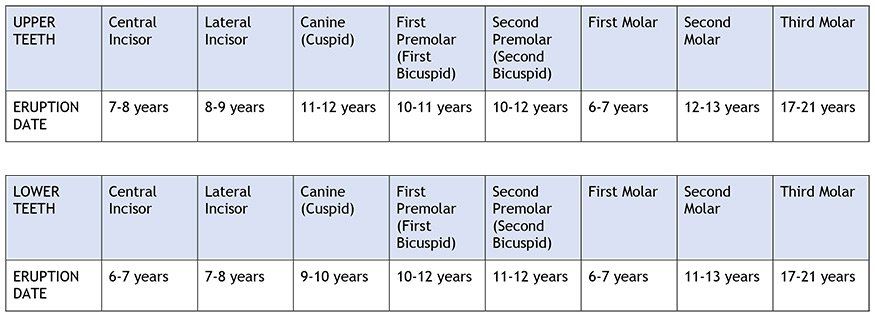
At about the age of 6, the first permanent teeth to erupt are usually the first permanent molars. These teeth are very important because they help shape the lower part of the face and affect the position of the other permanent teeth. These molars, upper and lower, do not replace primary teeth, but erupt behind the primary teeth. Sometimes these molars are mistaken for primary teeth, but they are not. Special care must be taken with cleaning the first permanent molars because they must last a lifetime for your child.
Oral Hygiene, Diet, Fluoride & Dental Visits
By the time permanent teeth are erupting into your child's mouth, he or she should be able to brush effectively. The use of floss is a more difficult skill to master and although a child can manage flossing at about the age of 8, parents should continue to monitor the effectiveness of brushing and flossing. Disclosing tablets or disclosing solution can be used to indicate areas of plaque missed by brushing and flossing.
Food habits that affect your child's entire life will be established at this stage. Be certain that your child understands that what and how he or she eats will affect their teeth. Clean teeth are less likely to decay, so brushing teeth after every meal will help prevent dental disease. Also, make certain that your child understands that snacking too often will affect tooth decay also. If needed, a food diary can be kept to track what kinds of food your child eats, and how often they eat. Your dentist will analyze the food diary and make recommendations based upon the information.
Fluoride is still very important for your child's good dental health. Topical fluorides can be applied at the dentist's office and daily fluoride supplements can be continued. Use of fluoridated toothpaste is also important, and after the age of 6, fluoridated mouthwash can be used.
Visits to the dentist for identification of treatment of any dental problems should be done on a regular basis. The child's teeth will be professionally cleaned, oral hygiene methods will be reviewed, topical fluoride will be applied when needed and X-rays may be taken. Sealants may be used to protect the chewing surfaces of your child's back teeth. The chewing surfaces contain tiny depressions and grooves called pits and fissures. These depressions and grooves accumulate plaque, which promotes tooth decay. These decay-prone areas can be sealed with painted on sealant to protect the chewing surfaces. Throughout the time of permanent teeth eruption (ages 7 to 21) good oral hygiene habits, proper diet, fluoride application, and regular dental visits are extremely important for your child to develop and maintain good oral health. Dr. Jaffe will determine if any dental problems develop and will be able to recommend specific treatment. With your help, your child's efforts, and professional care, your child can develop and maintain good oral health and keep their teeth for all of their lives.
Gum Surgery
Gum Recession Breakthrough Treatment, Also Known as Pinhole Gum Rejuvenation & Lunchtime Gum Lift
The Chao Pinhole® Surgical Technique (PST®), invented and patented by John Chao, D.D.S., is a scalpel-free, suture-free procedure for treating gum recession.
This procedure is performed by making a small hole with a needle in the gum tissue. Using specially designed instruments, the gum tissue is loosened and guided over the receded part of the tooth. Since there is no incision or suturing, patients can expect minimal post-operative symptoms (pain, swelling and bleeding). Most patients are also pleasantly surprised by the instant cosmetic improvement.
To learn more about the Pinhole® Surgical Technique, please contact our office or go to http://www.pinholesurgicaltechniqueparmaheightsohio.com/
for more information.
